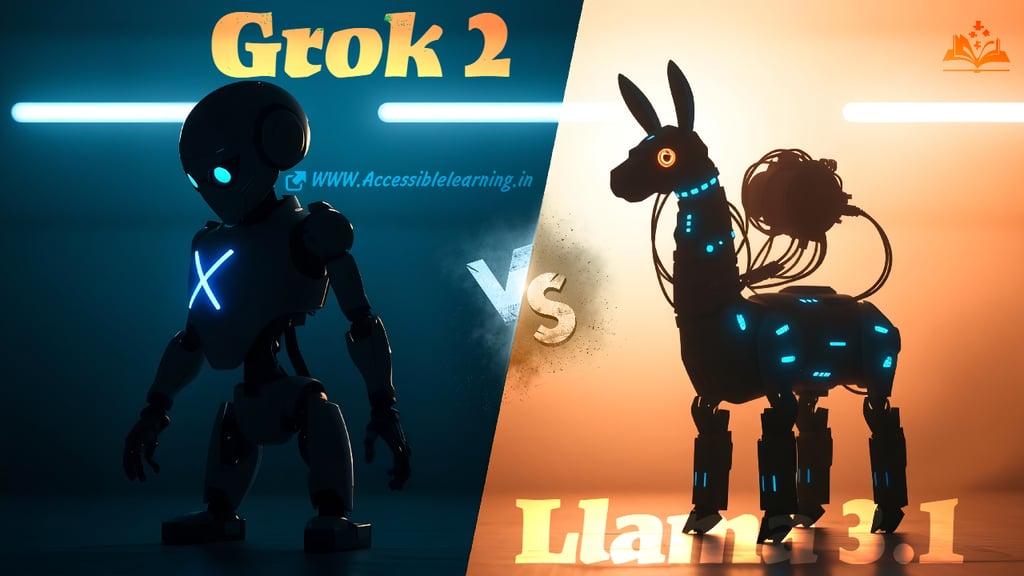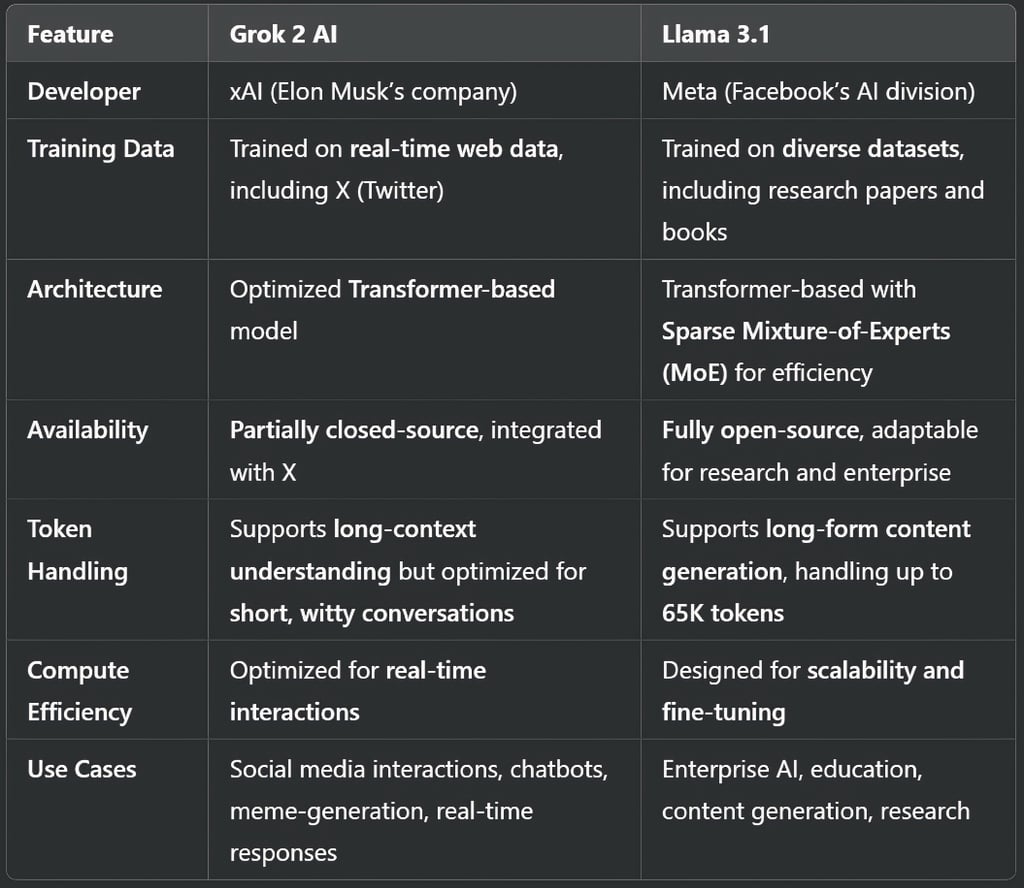
Grok 2 AI vs. Llama 3.1: Performance, Architecture & Use Cases Compared
Grok 2 AI vs. Llama 3.1—two cutting-edge AI models competing for dominance in conversational intelligence and open-source AI. Discover their features, strengths, weaknesses, and best use cases in this in-depth comparison.
AI ASSISTANTCOMPANY/INDUSTRYAI/FUTUREARTIST/CREATIVITY
Sachin K Chaurasiya
3/13/20254 min read


Artificial Intelligence (AI) is evolving at breakneck speed, and two of the biggest names making waves in this space are Grok 2 AI from xAI and Llama 3.1 from Meta. Both models aim to redefine how we interact with AI—whether in casual conversations, coding, or creative content generation.
But which one stands out? Let’s dive deep into the capabilities, performance, training data, architecture, and potential use cases of Grok 2 AI and Llama 3.1 to understand how they stack up against each other.
What is the main difference between Grok 2 AI and Llama 3.1?
Grok 2 AI is optimized for real-time interactions, witty responses, and social media integration, particularly within X (formerly Twitter). Llama 3.1, on the other hand, is an open-source model designed for scalability, research, and enterprise applications with better customization and fine-tuning capabilities.
Which AI model is better for businesses and developers?
Llama 3.1 is the better choice for businesses and developers since it is open-source and can be fine-tuned for various applications, including customer service, research, and AI-driven content creation. Grok 2 AI is more suited for real-time engagement on social media.
Can I use Grok 2 AI for research and academic purposes?
Not really. Grok 2 AI is primarily designed for conversational AI and real-time engagement rather than research and academic applications. Llama 3.1, with its open-source model and extensive dataset, is a better fit for research.
Is Llama 3.1 free to use?
Yes, Llama 3.1 is expected to follow Meta’s open-source approach, making it accessible for developers and researchers to use and fine-tune. However, the cost of running large-scale AI models still depends on computational resources.
How does Grok 2 AI integrate with X (Twitter)?
Grok 2 AI is designed to analyze real-time data from X and provide context-aware responses. This allows users to receive AI-driven insights, engage with trending topics, and interact with the AI in a more dynamic way.
Which AI is better for content creation?
Grok 2 AI is better for quick, witty, and social media-friendly content.
Llama 3.1 is better for long-form content, research-based articles, and professional writing.
Which AI model has better language support?
Llama 3.1 is expected to support multiple languages with advanced translation and linguistic capabilities. Grok 2 AI, while capable of multilingual conversations, is more focused on English-language interactions with an emphasis on humor and engagement.


Grok 2 AI
Developed by xAI, Elon Musk’s AI company
Designed for deep contextual understanding and enhanced conversational intelligence
Integrates seamlessly with X (formerly Twitter) for real-time insights
Focuses on humor, wit, and engaging dialogue
Likely follows a closed-source approach (similar to GPT models)
Expected to run on highly optimized transformer architecture
Strengths
✅ Real-time Insights: Can analyze trending topics on X, making it useful for dynamic discussions.
✅ Engaging Personality: Unlike traditional AI models, Grok 2 can generate witty, sarcastic, or humorous responses.
✅ Conversational AI Focus: Built to be more human-like in its interactions.
✅ Optimized for Speed: Likely employs low-latency inference techniques for real-time replies.
Weaknesses
❌ Limited Accessibility: If it follows a closed-source model, developers and enterprises may have limited control.
❌ Unknown Training Data Scope: Since it pulls from live data, biases or misinformation could creep in.
❌ Less Customization: Due to limited API access, businesses and researchers may struggle with modifications.
Llama 3.1 AI
Created by Meta (Facebook's parent company)
A part of the Llama (Large Language Model Meta AI) series, focusing on open-source AI development
Optimized for efficiency, accessibility, and enterprise use
Built on Meta’s experience with previous Llama models and fine-tuned for better performance
Expected to be open-source, just like its predecessors
Uses Sparse Mixture-of-Experts (MoE) layers for improved efficiency
Strengths
✅ Open-Source & Customizable: Ideal for developers and researchers looking to modify and fine-tune the model.
✅ Scalable for Businesses: Expected to be lightweight and efficient, making it suitable for enterprise solutions.
✅ Better at Knowledge-Based Tasks: Since it is trained on research-heavy data, it excels in academic and professional fields.
✅ Supports Fine-Tuning: With LoRA and QLoRA optimization, Llama 3.1 allows for cost-effective retraining.
Weaknesses
❌ Less Personality-Driven: May not match Grok’s wit, sarcasm, or humor in casual conversations.
❌ Not Real-Time: Unlike Grok 2, Llama 3.1 doesn’t have direct real-time data integration.
Performance & Architecture
Both models are large language models (LLMs), but they differ in architecture, scalability, and efficiency.




Potential Use Cases: Where Do They Shine?
Grok 2 AI Is Best For:
✔ Social Media & Meme culture: Engaging users with fun, witty, and sarcastic replies.
✔ Personal Assistants: AI-driven responses for platforms like X (Twitter).
✔ Casual Conversations: More human-like and entertaining interactions.
✔ Live-Stream Commentary: Potentially useful for AI-assisted real-time discussions.
Llama 3.1 Is Best For:
✔ Research & Academia: Open-source AI allows custom fine-tuning for education and research.
✔ Business & Enterprise AI: Scalable solutions for customer service, automation, and knowledge-based tasks.
✔ Content & Development: Can be used to build AI-powered applications, summarize documents, and code AI models.
✔ Multi-Language Support: Expected to have enhanced multilingual capabilities.
Future Potential: Who Will Lead the AI Race?
Grok 2 AI could dominate social interactions, entertainment, and meme culture, but its closed-source nature may limit its long-term adoption.
Llama 3.1 AI, on the other hand, will likely win over developers and researchers due to its open-source flexibility and scalability.
With Meta pushing for AI accessibility and Elon Musk's xAI focusing on disruptive innovation, both models have a significant role in shaping the future of AI.
🤖 Choose Grok 2 AI if you want a fun, real-time, witty AI companion for social media and entertainment.
📚 Choose Llama 3.1 AI if you need a powerful, research-oriented, customizable AI for business, education, and development.
In the battle of Grok 2 AI vs. Llama 3.1, the winner depends on what you need AI for. If you want an AI that’s humorous and engaging, Grok 2 AI might be your pick. But if you need an open-source powerhouse for research and enterprise, Llama 3.1 is the way to go.
Subscribe To Our Newsletter
All © Copyright reserved by Accessible-Learning Hub
| Terms & Conditions
Knowledge is power. Learn with Us. 📚


